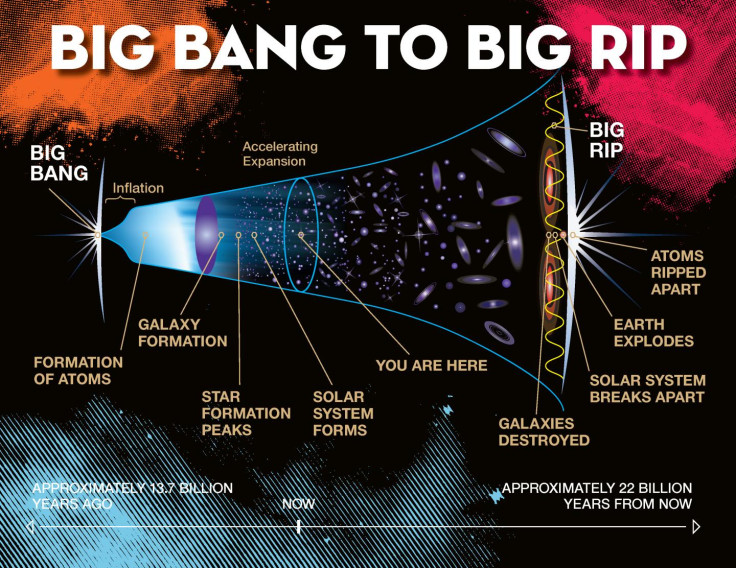Big Rip: Universe will pull itself apart in 22 billion years, mathematical model predicts

The universe will pull itself apart in around 22 billion years, with individual atoms disassembling themselves into radiation and unbound elementary particles, a new mathematical formulation suggests.
Since scientists discovered the universe is expanding, they have come up with several scenarios for the ultimate fate of the universe.
In the 'Big Freeze' scenario, the universe comes to an end in about 100 trillion years. At this point it would have grown so big the supply of gas will be too thin for stars to form and, as a result, existing stars will burn out leaving just black holes. Eventually, these will too evaporate as space gets ever colder.
In a more radical scenario – the 'Big Rip' – a type of phantom dark energy gets stronger over time. As the universe expands at such a great rate, in 22 billion years, material objects start to fall apart. An important aspect of this scenario is the ratio between the pressure and density of dark energy – if the value drops below minus one, the universe will be pulled apart.
Researchers at Vanderbilt University in Nashville have now come up with a new formula that appears to bridge a gap between the notion of viscosity and Einstein's general theory of relativity – a finding that has implications for the death of the universe.
Marcelo Disconzi, Thomas Kephart and Robert Scherrer published their findings in the journal Physical Review D.
Cosmological viscosity measures a fluid's resistance to expansion and contraction. Disconzi looked at relativistic fluids in objects that produce this phenomenon, including supernovae and neutron stars.
Previous models have not been able to account for what happens to ideal fluids (with no viscosity) when they travel at almost the speed of light, with huge inconsistencies in results. One suggested that in some conditions ideal fluids could travel faster than the speed of light – something Disconzi calls "disastrously wrong" because "nothing can travel faster than the speed of light".

The latest formula was based on one developed in the 1950s by French mathematician André Lichnerowicz. The scientists re-formulated previous equations of relativistic fluid dynamics to eliminate the flaw of fluids travelling faster than the speed of light.
Current understanding of the universe's expansion suggests it is being driven by dark energy. Most theories about dark energy do not take cosmic viscosity into account.
Disconzi said: "It is possible, but not very likely, that viscosity could account for all the acceleration that has been attributed to dark energy. It is more likely that a significant fraction of the acceleration could be due to this more prosaic cause. As a result, viscosity may act as an important constraint on the properties of dark energy."
In the current Big Rip scenario, the pressure and density shift that will lead to the universe's demise is known as the "phantom barrier". In Disconzi's model, the barrier does not exist, providing a natural way for the equation to fall below the all-important minus one point.
"In previous models with viscosity the Big Rip was not possible," Scherrer explained. "In this new model, viscosity actually drives the universe toward this extreme end state."
While the authors say the findings are promising, they accept far greater analysis must be carried out to analyse the equations numerically.
But even if this is the case, the Big Rip scenario is nothing to worry about as Earth will be long gone by this point. Current estimates suggest the oceans will evaporate in about 1.1 billion years and will be engulfed by the Sun in 7.5 billion years.
© Copyright IBTimes 2025. All rights reserved.






















